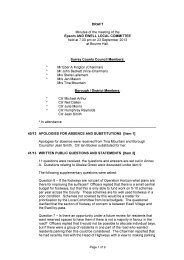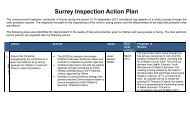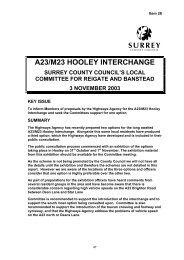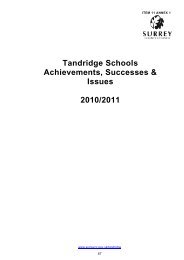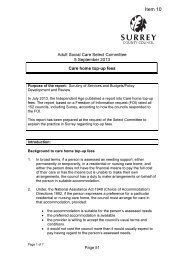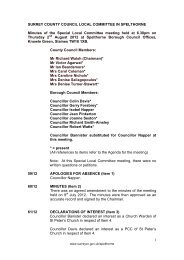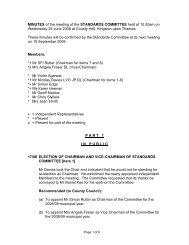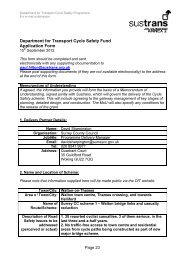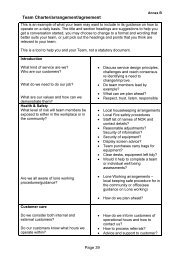Item 10 - Surrey County Council
Item 10 - Surrey County Council
Item 10 - Surrey County Council
You also want an ePaper? Increase the reach of your titles
YUMPU automatically turns print PDFs into web optimized ePapers that Google loves.
<strong>Item</strong> <strong>10</strong><br />
Environment and Transport Select Committee<br />
6 March 2013<br />
<strong>Surrey</strong> Local Flood Risk Management Strategy/<br />
Sustainable Drainage Approving Body<br />
Purpose of the report: Scrutiny of Services and Budgets/ Policy<br />
Development and Review<br />
To provide an update on the Lead Local Flood Authority (LLFA) regarding the<br />
local strategy and the Sustainable Drainage Approving Body (SAB).<br />
Introduction:<br />
1. In November 2012, the Environment and Transport Select Committee<br />
agreed to consider the <strong>Surrey</strong> Local Flood Risk Management Strategy<br />
and proposals for a SAB at its meeting in March 2013.<br />
<strong>Surrey</strong> Local Flood Risk Management Strategy<br />
2. Public consultation on the <strong>Surrey</strong> Local Flood Risk Management<br />
Strategy took place from September to December 2012. It is a statutory<br />
document required under the Flood and Water Management Act 20<strong>10</strong>.<br />
<strong>Surrey</strong> was one of the first Lead Local Flood Authorities to publish such a<br />
strategy. The list of questions we asked in our leaflet and online survey is<br />
at Annex 1. Some quotations from the consultation feedback are<br />
provided in the report in italics.<br />
Page 1 of 7<br />
2.1 There were 119 responses to the public consultation. 84% of<br />
responses were from residents and 14% represented a community<br />
group or a parish council.<br />
2.2 The organisations that responded included the Environment Agency,<br />
Highways Agency, Land Management Services (Ministry of Defence)<br />
and eight <strong>Surrey</strong> borough and district councils. A full list of the<br />
organisations that responded is at Annex 2.<br />
2.3 We reached 80% of county councillors and many borough and<br />
district councillors through further engagement. This included<br />
presentations to nine local committees (a public or private meeting).<br />
We held a member seminar in September 2012. The level of interest<br />
highlights the important role of our elected representatives in<br />
communications on local flood risk management.<br />
Page 49
2.4 We also met with a number of dedicated groups: the Lower Thames<br />
Planning Officers Group; <strong>Surrey</strong> Gypsy and Traveller Communities<br />
Liaison Forum; a strategy sub-group of the <strong>Surrey</strong> Flood Risk<br />
Partnership Board; a group of relevant officers in the county council;<br />
and <strong>Surrey</strong> borough and district drainage engineers.<br />
2.5 <strong>Surrey</strong> Chambers of Commerce invited its network of around 8,000<br />
businesses to contribute views in a Weekly News item. None of the<br />
consultation respondents identified themselves as representing a<br />
business.<br />
3. Overall those that responded to the consultation felt we are heading in<br />
the right direction, even if they had some reservations (total 94%). They<br />
also agreed with our ambitions (total 98%), even if they had some<br />
reservations. 59% of respondents said they need further information to<br />
help understand who is responsible for what and what support they could<br />
expect. 90 respondents provided additional comments, such as:<br />
‘The draft LFRMS is comprehensive, informative and suitably<br />
aspirational. It is also opportunely well-timed in seeking a more holistic<br />
view of flooding and the approaches for its containment.’<br />
‘The recent flooding in other parts of the country has highlighted the<br />
need to have a strategy – for all the areas you have highlighted,<br />
including drainage, infrastructure and insurance.’<br />
The importance of the local community engagement in all stages of the<br />
Flood Risk Management Strategy cannot be overemphasised. They<br />
know their area better than any agency...they can provide early<br />
warnings...and identify/ assist vulnerable people threatened by flooding.’<br />
‘Most landowners know they have a responsibility to keep ditches clear<br />
but they seem to be very lax.’<br />
Unfortunately, in my experience, with so many bodies involved, it is far<br />
too easy for the various Authorities to pass the buck and blame others.’<br />
3.1 As well as property-level flooding respondents were concerned<br />
about potential dangers to road users and pedestrians. Some<br />
respondents were concerned about the impact of heavy rainfall and<br />
‘flash-flooding’ including runoff from private land. Respondents<br />
identified many localised instances and long-term flooding problems.<br />
3.2 The 31 comments on our ambitions almost exclusively<br />
recommended better road drainage. This emphasises the<br />
importance of our ambition for a long-term drainage asset<br />
management strategy.<br />
3.3 We will use the feedback to update the strategy as follows:<br />
• Improve the look and feel of the strategy document and<br />
produce an executive summary.<br />
Page 2 of 7<br />
Page 50
• Make some technical corrections to the content, including<br />
more detail on local areas where it is available.<br />
• Insert case studies with new information and draw attention to<br />
positive initiatives.<br />
• Include roles and responsibilities of landowners.<br />
3.4 As the LLFA, we will continue to document and track the many local<br />
flood risk issues raised in the consultation and share these with any<br />
other flood risk authorities involved. We will also use feedback on<br />
how respondents want to be updated on flood risk management<br />
activity to develop our communications approach.<br />
3.5 We will take account of the issues and priorities of other risk<br />
management authorities, which included:<br />
• Establishing a realistic level of flood risk to accept.<br />
• Continuing to review the cost benefits of measures.<br />
• Taking full account of flood risk in the planning system.<br />
• Recognising the importance of sewerage system<br />
improvement.<br />
• Continuing to reduce risk to road users’ safety and and<br />
improve journey time reliability.<br />
• Understanding the risks and hazards which are made worse<br />
by the potential impact of climate change.<br />
• Accounting for the requirements and implications of the EU<br />
Water Framework Directive (WFD).<br />
• Continuing to identify opportunities for schemes to achieve<br />
multiple objectives.<br />
• Provision for delivering on wider environmental objectives.<br />
3.6 The <strong>Surrey</strong> Flood Risk Partnership Board will consider further<br />
actions related to partnership working. To reflect feedback from local<br />
committees and individual members, the Chairman Jason Russell<br />
has invited all <strong>Surrey</strong> borough and district councils not currently on<br />
the board to join.<br />
3.7 In response to officer feedback, we will continue to develop crossboundary<br />
working. This includes partnership working, where<br />
practical, with the South East Seven authorities, Thames Regional<br />
Flood and Coastal Committee, Lower Thames authorities and<br />
others.<br />
Establishment of Sustainable Drainage Approving Body (SAB)<br />
4. The Committee received an update on 12 January 2012 outlining the<br />
new duties. Considerable work has been undertaken in the interim to<br />
develop and test options. These were reported to the E&I Departmental<br />
Management Team on 12 December 2012 and are outlined in the<br />
Cabinet Member paper, dated 25 January 2013, included in Annex 3.<br />
Although the Government has not yet implemented Schedule 3 of the<br />
Flood and Water Management Act 20<strong>10</strong> we are developing a SAB with<br />
the intention of a phased introduction from April 2014.<br />
Page 3 of 7<br />
Page 51
4.1 As summarised by Defra, the key provisions in Schedule 3 of the Act<br />
are set out below:<br />
• A SuDS Approving Body (SAB) is created in unitary or county<br />
councils.<br />
• SABs must approve drainage systems for managing rainwater<br />
in new (re)development before construction begins.<br />
• Secretary of State must publish National Standards for the<br />
design, construction, operation and maintenance of SuDS.<br />
• SABs must approve drainage systems they judge to comply<br />
with the National Standards.<br />
• SABs must adopt and maintain approved SuDS that serve<br />
more than one property; where the SuDS function is<br />
approved.<br />
• The Water Industry Act 1991 is amended to make the right to<br />
connect surface runoff to public sewers conditional on the<br />
drainage system being approved by the SAB.<br />
• Sewerage Undertakers, Environment Agency, Internal<br />
Drainage Boards, British Waterways and Highway Authorities<br />
to be statutory consultees to the SAB.<br />
4.2 Government is developing the national standards as well as the<br />
secondary legislation required to implement these SuDS measures.<br />
To complement this, we are producing regional guidance with the<br />
‘South East 7’ (SE7) partners. This is to aid developers designing<br />
schemes and to regularise features that are likely to be offered for<br />
adoption and then become a maintenance liability for the council.<br />
4.3 In summary, we considered five options as follows:<br />
A) A SE7-wide body<br />
B) <strong>Surrey</strong> <strong>County</strong> <strong>Council</strong> in-house operation<br />
C) Partnership working with <strong>Surrey</strong> district and borough councils<br />
D) Full delegation for delivery through <strong>Surrey</strong> district and<br />
borough councils<br />
E) Delivery by a contractor.<br />
4.4 There is uncertainty surrounding the date and scope of the SAB.<br />
Economic situations are changing, which affects the level of planning<br />
and building control figures the SAB would need to respond to. So<br />
we will adopt a flexible approach. Overall we prefer Option C. We<br />
have discussed the potential for partnership working with all <strong>Surrey</strong><br />
district and borough councils. There is currently interest to develop<br />
joint working arrangements with three of them. We want to retain<br />
existing knowledge and expertise in the county.<br />
4.5 Defra is currently proposing to cover the costs of maintaining new<br />
SuDS in developments for the first three years. This is considered to<br />
be low initially but the long-term costs are largely unknown at<br />
present although commuted sums would be negotiated.<br />
Page 4 of 7<br />
Page 52
Conclusions:<br />
5. We will update the strategy to reflect key issues of concern.<br />
6. We will continue to prepare for the phased implementation of the SAB in<br />
response to the future implementation of Schedule 3 of the Flood and<br />
Water Management Act 20<strong>10</strong>.<br />
Financial and value for money implications<br />
7. The strategy states our intent to be ambitious in <strong>Surrey</strong> to our approach<br />
to securing national and additional funding sources. In January 2013 the<br />
Thames Regional Flood and Coastal Committee voted to increase the<br />
Local Levy on relevant councils. This will increase the Local Levy funding<br />
available to £<strong>10</strong>.5 million in 2013/14. Information provided by the<br />
Environment Agency, and available at the time, suggests that <strong>Surrey</strong> will<br />
benefit in the region of £37 million to 2017.<br />
Equalities Implications<br />
8. Only seven respondents (16%) were willing to answer some equality and<br />
diversity questions in the public consultation on the draft strategy. We<br />
consider this a low response. We will publish a full equality impact<br />
assessment with the final strategy.<br />
9. The <strong>Surrey</strong> Gypsy and Traveller Communities Liaison Forum responded<br />
to the public consultation. Issues identified were inundation of static sites<br />
sometimes over prolonged periods during flood events. Older people and<br />
children are likely to be at most risk. The community is under-supported<br />
by insurers. We will use this learning to identify what we and partners<br />
can do to help this community with respect to flood risk and flood events.<br />
Risk Management Implications<br />
<strong>10</strong>. Extreme weather events, continued building on floodplains and limited<br />
funding collectively affect how we are able to respond to flood incidents<br />
in <strong>Surrey</strong>. The strategy provides a real opportunity for us to work<br />
together with residents and businesses to promote ‘self help’, reduce risk<br />
and prepare for the future.<br />
The Environment Agency defines flood ‘risk’ as a combination of the<br />
likelihood of floods occurring and the consequences that can happen<br />
when they do occur. To manage the risks, we are improving our<br />
understanding of them. This will reduce the likelihood of incidents<br />
happening. It will help us to manage the potential consequences to<br />
people, businesses, infrastructure and services.<br />
Our partnership approach to all types of flooding will help us to manage<br />
risks. Our studies, such as surface water management plans in Epsom &<br />
Ewell and Woking, consider the interaction between surface water and<br />
sewage flooding. Joint work on strategic flood risk assessments and<br />
developing joint funding bids across neighbouring authorities will ensure<br />
Page 5 of 7<br />
Page 53
Page 6 of 7<br />
that all flood risks within a catchment (a broader area than a district or a<br />
borough) are taken into account.<br />
Recommendations:<br />
11. It is recommended that the Committee notes:<br />
a) The summary of responses to public consultation on the <strong>Surrey</strong> Local<br />
Flood Risk Management Strategy and how we are responding to them.<br />
b) The rise in the Local Levy (section 7).<br />
c) The role of Flood and Water Services Manager is advertised to lead<br />
future development of the SAB in <strong>Surrey</strong>.<br />
d) The above commences the establishment of the SAB, based on<br />
Phase1 and/ or Phase 2 of Option C (or a hybrid of other options)<br />
detailed in Annex 3, which provides the flexibility to adapt to changed<br />
circumstances and demands, through negotiations with Guildford,<br />
Runnymede and Reigate & Banstead Borough <strong>Council</strong>s.<br />
e) The committee considers appropriate ways for ongoing consultation<br />
with members at the appropriate time.<br />
Next steps:<br />
The <strong>Surrey</strong> Flood Risk Partnership Board will meet on Friday 15 March. The<br />
board will consider the feedback to the public consultation. <strong>Surrey</strong> <strong>County</strong><br />
<strong>Council</strong> Cabinet will consider the final draft of the strategy in May 2013.<br />
We will complete a Habitats Regulations Assessment and a final Strategic<br />
Environmental Assessment.<br />
We will recruit the Flood and Water Services Manager, initially for a fixed two<br />
year fixed term period to further develop Option C.<br />
-------------------------------------------------------------------------------------------------------<br />
Report contacts:<br />
Deborah Fox, Strategy and Commissioning Team Manager, Environment and<br />
Infrastructure Directorate (strategy).<br />
Contact details: 020 8541 9381 deborah.fox@surreycc.gov.uk<br />
Peter Agent, Asset Planning Group Manager, <strong>Surrey</strong> Highways.<br />
Contact details: 01483 517540 peter.agent@surreycc.gov.uk<br />
Sources/background papers:<br />
Report to Environment & Transport Select Committee held on 8 November<br />
2012.<br />
Page 54
Report to Environment & Transport Select Committee held on 12 January<br />
2012.<br />
Report to Cabinet Member on 25 January 2013.<br />
Survey Monkey summary report: Draft <strong>Surrey</strong> Flood Risk Management<br />
Consultation 2012 (unpublished).<br />
Draft <strong>Surrey</strong> Local Flood Risk Management Strategy 2012.<br />
Flood and Water Management Act 20<strong>10</strong>.<br />
Page 7 of 7<br />
Page 55
This page is intentionally left blank<br />
Page 56



![[15 February 2013] PDF 66 KB - Surrey County Council](https://img.yumpu.com/51850903/1/184x260/15-february-2013-pdf-66-kb-surrey-county-council.jpg?quality=85)
